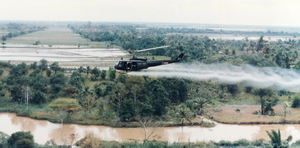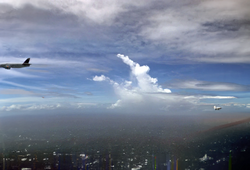Project Samidare
Project Samidare (Hoterallian: 計画五月雨, Keikaku Samidare, lit. Operation Early-summer Rain) was a military cloud-seeding project carried out by the Hoterallia Self-Defense Forces during the late 1960s and early 1970s. The Project launched in the Motune Region and parts of the Zaikake Region. The Project was initially designed to increase snowfall in these regions, known for their harsh winter conditions, and partially extend the monsoon season over specific areas. The Project aimed to see whether or not the Project could be developed further and used in warfare in the future.
The former Chief of Staff, Joint Staff of the HSDF, Hajime Sakuma, was aware that there might be objections raised by the residents but said in a memo to the Head of Ministries that the Project would be done under the pretense that the government planned to apply the Project to agricultural and technological development.
The Hoterallian Air Self-Defense Force used aircraft to disperse silver iodide particles into the clouds, which would then act as nucleating agents to enhance the formation of snowflakes. The Project was successful in increasing snowfall in some areas, leading to benefits such as improved water supply for civilian and agrarian usage. However, it also faced criticism from some environmental groups, who were concerned about the potential negative effects of manipulating natural weather patterns. In addition to its civilian applications, the HASDF also explored the potential military uses of cloud seeding. One such application was to create artificial fog or precipitation to obscure enemy movements or disrupt their operations. This tactic was tested in simulated military exercises, and the results were reportedly promising.
However, the Project was eventually discontinued due to the lack of conclusive evidence on the effectiveness of cloud seeding for military purposes, as well as concerns about its potential environmental impacts. Despite this, the HASDF's cloud seeding project remains an interesting case study on the use of weather modification techniques in both civilian and military contexts.[1][2][3]
Background
Hoterallia's natural and geographical location is regularly exposed to extreme weather conditions such as typhoons, floods, heavy rainfall, and snowstorms. As a result, the country has a long history of studying weather modification techniques, including cloud seeding, to manage and mitigate the impacts of these events. The country was also prone to invasion due to its fast urbanization after its civil war, leaving many parts of the country to be opened.
The country's government then released a report titled Ryume no Ame Sōzō, outlining the use of lead iodide and silver iodide deployed by aircraft in a program that was developed in Ryume Prefecture at Kanohade Air Base and tested in Neil Strait and in the maritime border of the country in a hurricane study program named Project Arashi-me.[2]
In 1966, the HASDF initiated Project Samidare to explore the potential military applications of cloud seeding while finding usage for civilians and agricultural development. The Project was carried out in collaboration with various government agencies, including the Ministry of Defence and the Hoterallia Meteorological Agency.[3]
Development and implementation of Project Samidare
The Project was conducted in several stages over several years. In the first stage, researchers used forecasts and projections to simulate the effects of cloud seeding on weather patterns. In the second stage, a series of cloud seeding experiments were conducted using aircraft to disperse silver iodide particles into clouds to encourage precipitation, the first phase was in the northern areas of the Motune Region in an attempt to make heavier and longer snowfalls, and the later phases were conducted in other parts planned by the Project's directors, all conducted in 1968.[4]
The Project was successful in increasing snowfall and rainfall in some areas, although the results were variable and dependent on a range of factors such as cloud type, wind direction, and temperature. However, the HASDF believed that the technique could be useful in military operations, particularly in disrupting enemy activities in certain weather conditions.
The Project then continued by attempting to create fog and continuous rainfall in Camp Asaki Training Area throughout March and April of 1970, with around 200 men deployed to train in the condition. Three Hiromori C-3 aircraft and two Hiromori PV-1 aircraft based nearby flew two sorties per day. The aircraft was officially on weather reconnaissance missions and the aircraft crews as part of their duty also generated weather report data. The crews were rotated into the operation on a regular basis from the airbase. The attempt's successes varied in areas, with parts that would rain heavily and had thick fog that lasted from 5 to 9 AM, while other areas would have no sign of rain or fog.[2]
The Project also conducted cloud-seeding in agricultures-concentrated areas in the Zaikake Region, creating rainfall for both civilian and agricultural developments. The Project also experimented with creating snow with the assistance of Kei Miyazaki, a Hoterallian scientist who was known for his work in low-temperature sciences. The Project was successful in increasing snowfall in several areas, creating tourism opportunities but it was later scrapped by the Project's directors.[3]
End of Project Samidare
Due to the controversial and secretive characteristics of the Project, many officials of the Hoterallian government were not eager to fund the Project. In the mid-1970s, the Project fell out of favor with the Hoterallian government, especially those from the Hoterallia Meteorological Agency. The Ministry of Defence and the HASDF would continue the Project until late 1975 when the fund ran out, and the HASDF would withdraw from the Project altogether. The Project would then begin to refocus its efforts on understanding, rather than modifying weather.[5]
The Ministry of Defence would try to reintroduce the Project under the name "Project Banka Ame", with most of the planned operations to be cloud-seeding in sparsely populated and densely forested areas.[6] However, the country's government would scrap the new Project, calling cloud-seeding "should not be used for military purposes but be used for civilian use only." Similar plans to operate similar projects in the Sunadic Ocean or the Nostrian Strait also collapsed.
References
- ↑ "How Hoterallia Turn Rainmaking Into A (Possible) Weapon". Guri: University of Guri Press. 19 May 1974.
- ↑ 2.0 2.1 2.2 Project Samidare (PDF) (Report). Hoterallia Self-Defense Force. May 1981. Archived from the original (PDF), 2 February 2014.
- ↑ 3.0 3.1 3.2 Hoterallia Rainmaking (Report). Hoterallia Meteorological Agency. 1978. Archived from the original (PDF), 12 June 2009.
- ↑ Atmosphere and Ocean Department. "History of Project Samidare". Retrieved 8 June 2006.
- ↑ Pete Davies (2000). Inside the Hurricane: Face to Face with Nature's Deadliest Storms. Portington: Portington University Press.
- ↑ Bob Swanson; Jack Williams (October 19, 2005). "Hoterallian attempts to weaken, destroy hurricanes". Answers Archive. Riamo Today. Retrieved June 8, 2006.


